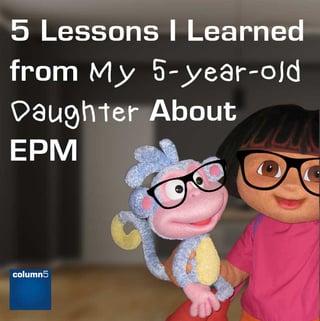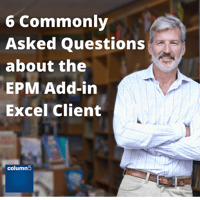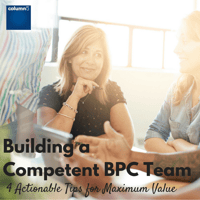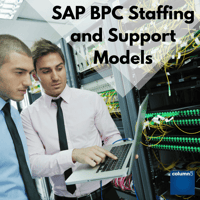 This past weekend, my daughter turned 5. Everyone knows how important daughters are to their fathers, and I couldn’t be happier with my daughter’s “mermaid & unicorn phase”. However, at her birthday party, dark clouds began to gather as she invited her “boyfriend” from school. She held hands with this little guy and even thinking about it now, it makes me slightly crazy. I can only imagine where I will be in 10 years. Keep me in your thoughts and prayers, please.As I was simmering in my inevitable future angst, I replayed in my mind where my daughter had been in her life, and a thought occurred to me…how easily applied some of the lessons she had gleaned could be applied to SAP Enterprise Performance Management (EPM) projects. Now I am not saying that what is common knowledge to 5-year-olds remains elusive for some SAP EPM customers…well, maybe I am saying exactly that. Let’s explore this together.
This past weekend, my daughter turned 5. Everyone knows how important daughters are to their fathers, and I couldn’t be happier with my daughter’s “mermaid & unicorn phase”. However, at her birthday party, dark clouds began to gather as she invited her “boyfriend” from school. She held hands with this little guy and even thinking about it now, it makes me slightly crazy. I can only imagine where I will be in 10 years. Keep me in your thoughts and prayers, please.As I was simmering in my inevitable future angst, I replayed in my mind where my daughter had been in her life, and a thought occurred to me…how easily applied some of the lessons she had gleaned could be applied to SAP Enterprise Performance Management (EPM) projects. Now I am not saying that what is common knowledge to 5-year-olds remains elusive for some SAP EPM customers…well, maybe I am saying exactly that. Let’s explore this together.
 1. Importance of a Good Map
1. Importance of a Good Map
Here in the states, we have a TV program called “Dora the Explorer”. She is a precocious young girl who explores
all over and has to overcome obstacles with the help of the audience. She makes use of her equipment that she calls upon when she needs assistance. Invariably, the first tool she calls on is the “map”. She summons the map with a highly repetitive song aptly titled: “The Map Song”. Eventually, after serenading you with the auditory equivalent of a whining power drill, the map unfurls and reveals the information to guide Dora to her destination.
We all know that the quality of the output from your EPM system will be a competitive advantage for your organization. For that reason, much is expected from all EPM solutions. At the same time, EPM is an inherently difficult process and technology to get just right. When any opportunity presents itself with EPM, its important to consult the map. While this seems obvious, in our surveys, as many as 75% of customers do NOT HAVE A ROADMAP. Hence, every decision about their EPM journey is likely to lead to a suboptimal destination. The first thing you need when going on any journey, and especially an EPM journey, is a good map.
For Dora aficionados (read: masochists), here’s a bonus track: the equally infectous backpack song.
My apologies for the diversion. Let’s move on.
2. The Importance of a Group of Friends
Some things that are true at age 5, can also be proved to be even truer later in our lives. Again, these axioms have a special application to challenges found in EPM. One situation I see often is isolation of EPM fluent personnel. I break that down this way: every company with any  significant operations has some form of EPM solution. Every EPM solution has at most a very small number of coworkers assigned to manage the solution, often just one person. Unlike ERP, BI, office productivity software and other much more widely distributed solutions, it is difficult to cultivate momentum by comparing techniques with internal peers - especially if you are an army of one! Despite the ubiquity of EPM solutions and specialists, this particular role of solution owner tends to be one where workers toil in anonymity behind the scenes. If you ever get comments from your peers saying things like, “I don’t know how you know so much about that system”, “I will never know as much as you do”, “you’re the BPC/BFC/EPM master!” etc…you know what I am talking about.
significant operations has some form of EPM solution. Every EPM solution has at most a very small number of coworkers assigned to manage the solution, often just one person. Unlike ERP, BI, office productivity software and other much more widely distributed solutions, it is difficult to cultivate momentum by comparing techniques with internal peers - especially if you are an army of one! Despite the ubiquity of EPM solutions and specialists, this particular role of solution owner tends to be one where workers toil in anonymity behind the scenes. If you ever get comments from your peers saying things like, “I don’t know how you know so much about that system”, “I will never know as much as you do”, “you’re the BPC/BFC/EPM master!” etc…you know what I am talking about.
Yeah, you’ve officially achieved guru status. But where does a guru go to make sure they are as guru-y as possible? Well here is the important correlation to a 5-year-old experience: you are much more capable when you have friends with you. When faced with so many firsts, 5-year-olds learn a lot from their peers, often gaining the courage to try something new only after witnessing others successfully complete the feat. The EPM isolation tendency works to directly prevent this beneficial effect. Pockets of users in an organization only “know what they know”, and often this means they subscribe to some relatively narrow perspectives and sometimes even half truths about EPM processes and solutions. Where can one go to break out from the shadows of their organization to be among fellow EPM travelers who know just what challenges you are facing?
Column5 offers our EPM Leadership Summit. If you identify with the above sentiments even partially, you will want to explore our EPM Summit program to interact with like minded peers. Every year, we have many individuals come away with confidence and inspiration. And while we can't offer all the benefits a 5-year-old would expect: like traditional singing of 'kumbaya', and nap time, we do have cookies and ice cream!
3. The Importance of a Partner
 In addition to a map and friends, sometimes 5-year-olds get in over their heads. In that case, they need to have a nearby authority figure to call on. This could be a parent, a teacher, or some other adult who can help the child out of a jam. This help could be someone who rescues them outright from an impossible situation, or it could be a very small, well-placed boost to get over the hurdle. In any case, having someone who knows what to do and has the skills needed to make rapid progress can be invaluable.
In addition to a map and friends, sometimes 5-year-olds get in over their heads. In that case, they need to have a nearby authority figure to call on. This could be a parent, a teacher, or some other adult who can help the child out of a jam. This help could be someone who rescues them outright from an impossible situation, or it could be a very small, well-placed boost to get over the hurdle. In any case, having someone who knows what to do and has the skills needed to make rapid progress can be invaluable.
This is the role I see fulfilled by partners. If you are soaring to new heights and have a partner you know you can rely on to cover your back…congratulations. If you are unsure if your partner is a good fit…maybe you’re experiencing confusing situations that your partner can’t explain, or they are not as effective as you’d like, I encourage you to explore your options. I suggest taking a look at our firm: Column5. Our firm is unique in that we have the breadth of specialties to implement and support EPM at the highest levels. Much larger firms do not have all the specialties, nor at the depth we do.
OutlookSoft History: The Start of BPC and Column5
4. The Importance of Clearly Defined Roles
The next thing I see work with 5-year-olds is even at that age, they thrive on having the right job with a clearly defined role. Recently my daughter told me, beaming with pride, that she was appointed the “kindness reporter” for her class. Her job is to observe the class’s behavior and relay any acts of kindness to the teacher for them to recognize when students are being kind to each other. She says flatly, most days there is nothing to report. Even when I press to uncover some act of kindness, she informs me that “most kids don’t always do kind things, Dad”. Well, we needn’t emulate every aspect of 5-year-old life!
The Changing Role of Finance: Results Reporting to Business Partner
The positives of this effect underscore an important component of EPM success: clearly defined roles and appointing people to fulfill those tasks. Who owns the responsibility for your users’ EPM skills? Who is monitoring performance? Who owns the responsibility for support for your organization? Who is tasked with monitoring available patches and service packs to ensure your system is kept up to date? Who owns data reconciliation and accuracy? In many cases, we see gaps in these important roles. As each role is unfilled, there is a risk. If someone isn’t accountable for the outputs, then there is a good chance the task won’t be completed at all, and if it is done partially, the missing pieces will prove costly. Define the jobs, assign them, and hold your team accountable...and be sure to recognize kindness along the way.
5. The Importance of Courage
Finally, this is an easy thing for 5-year-olds to do: you have to have the courage try new things! When you’re 5, most things are ‘new’. EPM is a powerful solution that can add tremendous value to your company. Staying on the well-worn paths for your long established EPM processes may seem safe, but this mindset really constrains the potential ROI of your solution. For inspiration - I encourage you to explore our Webcast Library, the EPM Leadership Summit, and customer case studies. We're still working on our highly repetitive theme songs, but I hope you find some useful information nonetheless. Best of luck in your EPM journey!
More Content You Might Like:
Author Bio:
 David Den Boer founded Column5 Consulting in 2005. Under David´s leadership, Column5 has evolved beyond its reputation for technically superior solutions to be an influential global provider of high—value EPM solutions. His prior experience includes consulting experience as Director of Services at OutlookSoft from 2000 to 2005.
David Den Boer founded Column5 Consulting in 2005. Under David´s leadership, Column5 has evolved beyond its reputation for technically superior solutions to be an influential global provider of high—value EPM solutions. His prior experience includes consulting experience as Director of Services at OutlookSoft from 2000 to 2005.
David Den Boer, Founder & CEO














